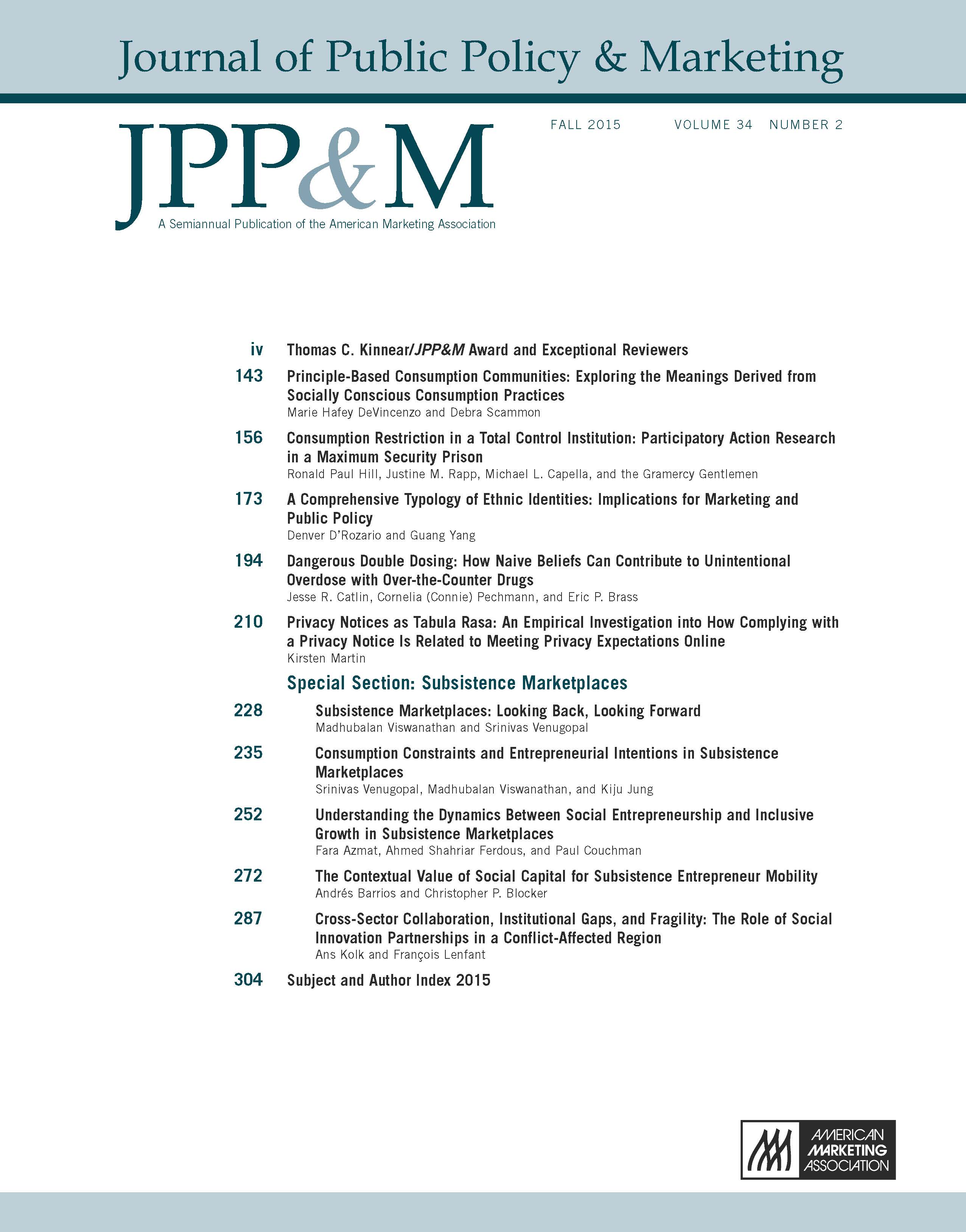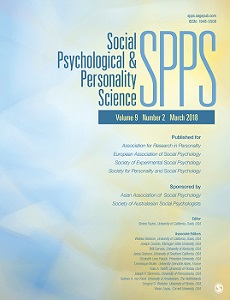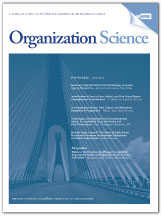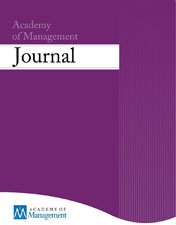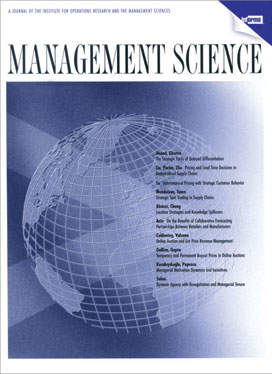Academic articles
Practitioner articles
Working papers
Books
Book chapters
Case studies
Other publications
Subject(s)
Economics, politics and business environment; Ethics and social responsibility; Marketing; Strategy and general management
Keyword(s)
Corporate social responsibility (CSR); CSR regulation; customer–supplier relationship; power; stakeholder pressure
In face of the increasing attention on issues of sustainability and corporate social responsibility (CSR) by the general public and policy makers, companies have put growing emphasis on ensuring CSR along their supply chains. In this vein, existent research has produced evidence that companies can increase their suppliers’ CSR engagement by exerting explicit pressure on them, e.g., through contractual clauses. Adding to this conventional chain of CSR enforcement, this paper conceptualizes and empirically validates a so far undescribed extended chain of CSR enforcement that also leads to higher levels of a supplier firm’s CSR engagement irrespective and even in the absence of explicit pressure by its customer company. In particular, a customer firm’s CSR orientation in interaction with a powerful position in the supply chain leads suppliers to perceive pressure to engage in CSR regardless of factually exerted pressure. As a result, suppliers are likely to increase their CSR engagement in order to be customer oriented or in preemptive obedience. These results entail substantial implications for policy makers as well as marketing academics and managers.
Volume
36
Journal Pages
331–347
ISSN (Print)
0743–9156
Subject(s)
Human resources management/organizational behavior
Keyword(s)
Negotiations, emotion, conflict, selfishness, timing, communication, social norms, impasses, anger
Prior research has focused on the influence of emotional expressions on the value of negotiated outcomes. Across three studies, we demonstrate that people interacting with angry counterparts become more likely to walk away from a negotiation, resulting in an impasse. In Study 1, participants who encountered counterparts expressing anger were more likely to choose an impasse, relative to those with neutral counterparts. In Study 2, building on the emotion-as-social-information model, we found that inferences of selfishness mediate the effect of angry expressions on impasses. In Study 3, we found that timing moderates the relationship between angry expressions and impasses. Furthermore, we demonstrated that perceptions of inappropriateness mediate the interactive effect of timing and angry expressions on impasses. Taken together, our work reveals that expressing anger is risky in negotiations because people infer that angry counterparts are selfish and become more likely to exit negotiations.
With permission of SAGE Publishing
Volume
8
Journal Pages
706–714
ISSN (Online)
19485514
ISSN (Print)
19485506
Subject(s)
Economics, politics and business environment
Keyword(s)
Long-term contracts, breakup fees, foreclosure
JEL Code(s)
D11, D21, D43, D86, L13, L51
Considering markets with nonpivotal buyers, we analyze the anticompetitive effects of breakup fees used by an incumbent facing a more efficient entrant in the future. Buyers differ in their intrinsic switching costs. Breakup fees are profitably used to foreclose entry, regardless of the entrant's efficiency advantage or level of switching costs. Banning breakup fees is beneficial to consumers. The ban enhances the total welfare unless the entrant's efficiency is close to the incumbent's. Inefficient foreclosure arises not because of rent shifting from the entrant, but because the incumbent uses a long-term contract to manipulate consumers' expected surplus from not signing it.
Copyright ©2017 by the American Economic Association.
Volume
107
Journal Pages
2041–2071
Subject(s)
Finance, accounting and corporate governance
Keyword(s)
Bank lending, relationship specific information, discretion, loan defaults, monitoring, screening
JEL Code(s)
G20, G21
Using a unique dataset of more than 1 million loans made by 296 German banks, we evaluate the impact of many aspects of customer–bank relationships on loan default rates. Our research suggests a practical solution to reducing loan defaults for new customers: Have the customer open a simple transactions account – savings or checking account. Observe for some time and then decide whether to make a loan. Loans made under this model have lower default, as banks can use historical data about their borrowers to establish a baseline against which new client-related information can be evaluated. Banks assemble this historical information through relationships of different forms. We define relationships in many different ways to capture non-credit relationships, transaction accounts, as well as the depth and intensity of relationships, and find each of these can provide information that helps reduce default – even establishing a simple savings or checking account and observing the activity prior to loan granting can help reduce loan defaults. Our results show that banks with relationship-specific information act differently compared with banks that do not have this information both in screening and subsequent monitoring borrowers which helps reduce loan defaults.
With permission of Elsevier
Volume
31
Journal Pages
1–15
Subject(s)
Human resources management/organizational behavior; Technology, R&D management
Keyword(s)
Innovation, knowledge recombination, recombinant breadth, differential selection, patent, patent approval, patent impact, institutional gatekeeping
JEL Code(s)
O310, O330
Theories of innovation and technical change posit that inventions that combine knowledge across technology domains have greater impact than inventions drawn from a single domain. The evidence for this claim comes mostly from research on patented inventions and ignores failed patent applications. We draw on insights from research into institutional gatekeeping to theorize that, to be granted, patent applications that span technological domains must have higher quality than otherwise comparable, narrower applications. Using data on failed and successful patent applications, we estimate an integrated, two-stage model that accounts for this differential selection. We find that more domain-spanning patent applications are less likely to be approved, and that controlling for this differential selection reduces the estimated effect of knowledge recombination on innovative impact by about one-third. By conceptualizing the patent-approval process as a form of institutional gatekeeping, this paper highlights the institutional underpinnings of and constraints on the innovation process.
© 2017, INFORMS
Volume
28
Journal Pages
133–151
Subject(s)
Technology, R&D management
Keyword(s)
innovation search, novelty, professional services firms, R&D project selection, selection panels
Building on a unique, multi-source, and multi-method study of R&D projects in a leading professional service firm, we develop the argument that organizations are more likely to fund projects with intermediate levels of novelty. That is, some project novelty increases the share of requested funds received, but too much novelty is difficult to appreciate and is selected against. While prior research has considered the characteristics of the individuals generating project ideas, we shift the focus to panel selectors and explore how they shape the evaluation of novelty. We theorize that a high panel workload reduces panel preference for novelty in selection, whereas a diversity of panel expertise and a shared location between panel and applicant increase preference for novelty. We explore the implications of these findings for theories of innovation search, organizational selection, and managerial practice.
With permission of the Academy of Management
Volume
60
Journal Pages
433–460
Subject(s)
Human resources management/organizational behavior
Keyword(s)
Crowdsourcing science, replication, reproducibility
Researchers agree that replicability and reproducibility are key aspects of science. A collection of Data Descriptors published in Scientific Data presents data obtained in the process of attempting to replicate previously published research. These new replication data describe published and unpublished projects. The different papers in this collection highlight the many ways that scientific replications can be conducted, and they reveal the benefits and challenges of crucial replication research. The organizers of this collection encourage scientists to reuse the data contained in the collection for their own work, and also believe that these replication examples can serve as educational resources for students, early-career researchers, and experienced scientists alike who are interested in learning more about the process of replication.
This work is licensed under a Creative Commons Attribution 4.0 International License CC-BY.
Volume
4
ISSN (Online)
2052-4463
Subject(s)
Finance, accounting and corporate governance
Keyword(s)
Financial disintermediation, crowdfunding, consumer lending
JEL Code(s)
G01, G20, G21, G23
This paper analyzes the substantially growing markets for crowdfunding, in which retail investors lend to borrowers without financial intermediaries. Critics suggest these markets allow sophisticated investors to take advantage of unsophisticated investors. The growth and viability of these markets critically depends on the underlying incentives. We provide evidence of perverse incentives in crowdfunding that are not fully recognized by the market. In particular we look at group leader bids in the presence of origination fees and find that these bids are (wrongly) perceived as a signal of good loan quality, resulting in lower interest rates. Yet these loans actually have higher default rates. These adverse incentives are overcome only with sufficient skin in the game and when there are no origination fees. The results from the analysis in this paper provide more general implications for crowdfunding, its structure and regulation.
© 2016 INFORMS
Volume
63
Journal Pages
587–608
ISSN (Online)
1526-5501
ISSN (Print)
0025–1909
Subject(s)
Economics, politics and business environment
Keyword(s)
LeChatelier principle, cost passthrough, multiproduct oligopoly
JEL Code(s)
C72, D43, D11
The LeChatelier-Samuelson principle states that, as a reaction to a shock, an agent's short-run adjustment of an affected action is smaller than its long-run adjustment (when the agent can also adjust other related actions). We extend the principle to strategic environments where the long-run adjustment also accounts for other players adjusting their strategies. We show that the principle holds for supermodular games (strategic complements) satisfying monotone comparative statics and provide sufficient conditions for the principle to hold in games of strategic substitutes/heterogeneity. We discuss the principle's implications for cost pass-through of multiproduct firms.
Volume
168
Journal Pages
44–54
Subject(s)
Information technology and systems; Technology, R&D management
Keyword(s)
open innovation, review, research, theory, contingencies, knowledge, collaboration
JEL Code(s)
D83, O30
This paper provides an overview of the main perspectives and themes emerging in research on open innovation (OI). The paper is the result of a collaborative process among several OI scholars – having a common basis in the recurrent Professional Development Workshop on “Researching Open Innovatio” at the Annual Meeting of the Academy of Management. In this paper, we present opportunities for future research on OI, organised at different levels of analysis. We discuss some of the contingencies at these different levels, and argue that future research needs to study OI – originally an organisational-level phenomenon – across multiple levels of analysis. While our integrative framework allows comparing, contrasting and integrating various perspectives at different levels of analysis, further theorising will be needed to advance OI research. On this basis, we propose some new research categories as well as questions for future research – particularly those that span across research domains that have so far developed in isolation.
Volume
24
Journal Pages
8–40

